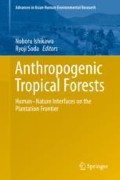Abstract
Rattan is a non-timber forest product important to both forest biodiversity and local livelihoods in Southeast Asia. In this chapter, we aim to understand the changing patterns of socioeconomic activities in local communities and in the global market, as well as human–nature interactions in Sarawak from the perspective of the transition of rattan utilisation from the past to the present. For the analysis, we employed a multidisciplinary approach using a socioecological survey and historical study, and set three spatial scales as a framework. First, we found that people recognise and make use of various rattan species based on the diversity of surrounding forests. The high diversity of rattan species in these forests supports the preservation of knowledge and culture, and local communities are able to acquire multiple benefits from the forests through rattan. Second, we show the effects of development on traditional knowledge and rattan use by comparing a rural village to villages close to more developed urban areas in which people use a limited number of rattan species because primary forests are no longer accessible. Utilisation of rattans in peri-urban villages has also changed, departing from the close relationship with primary forests that is vital for selecting and using particular rattan species for various needs. Third, we pay attention to the emergence of the regional market for rattan materials provided by a rattan-processing factory in the urban area of Bintulu. In suburban villages, inhabitants who have limited access to primary forests now buy machine-processed rattans for making crafts, possibly leading to a decline of traditional knowledge and the culture of rattan in these communities. Finally, we discuss the trajectory of rattan exports from Sarawak on a global scale over the last 150 years. From the late nineteenth century onwards, rattan exports for the global market enabled local people to gain commercial profits, and we confirm that such a trade connection has lasted through the boom of rattan exports from Sarawak in the mid-1980s. As such, this local to global, past to present study of rattan shows that Sarawak’s highly biodiverse society, which depends on various kinds of natural resources from primary forests, has altered in response to the impacts of the world economy and land-use change over the last two centuries.
Access this chapter
Tax calculation will be finalised at checkout
Purchases are for personal use only
Notes
- 1.
Rumah refers to the Iban longhouse, a traditional residence for multiple families with both private and communal living areas that forms a village.
- 2.
According to exchange rates in 2017, SG$5 was approximately equal to US$3.49–3.71.
- 3.
RM30 was approximately equal to US$9.05–9.08 in January and February 2014.
References
Biro Pusat Statistik. 1970–1996. Statistik perdagangan luar negeri Indonesia: Ekspor menurut jenis barang, negeri tujuan dan pelabuhan ekspor asal [Indonesian foreign trade statistics: Exports by commodity, country of destination and port of export]. Jakarta: Biro Pusat Statistik.
Blehaut, Jean-François. 1994. Iban baskets. Kuching: Sarawak Literary Society.
Central Statistics Bureau Government of Sarawak. 1961–1996. Statistics of external trade for the year. Kuching: Central Statistics Bureau Government of Sarawak.
Chai, Paul P.K. 2000. Development of Lanjak Entimau wildlife sanctuary as a totally protected area, phase II: Project 15/95 rev. 3(F) final report. Yokohama/Kuching: International Tropical Timber Organisation/Sarawak Forest Department.
de Beer, Jenne H., and Melanie J. McDermott. 1996. The economic value of non-timber forest products in Southeast Asia: With emphasis on Indonesia, Malaysia and Thailand. Amsterdam: Netherlands Committee for IUCN.
Department of Trade and Customs, Colony of Sarawak. 1954–1960. Annual statistics for the year. Kuching: Government Printer.
Department of Trade and Customs, Sarawak. 1920–1940, 1946–1953. Annual reports. Kuching: Government Printer.
Dransfield, John. 1992. The rattans of Sarawak. Kew: Royal Botanic Gardens, Kew and Kuching Sarawak Forest Department.
Dransfield, John, and N. Manokaran. 1994. Rattans. Wageningen: Centre for Agricultural Publishing and Documentation (PUDOC), Plant Resources of South-East Asia (PROSEA) No. 6.
Dransfield, John, Florentino O. Tesoro, and N. Manokaran. 2002. Rattan: Current research issues and prospects for conservation and sustainable development, Non-wood forest products. Vol. 14. Rome: Food and Agriculture Organisation of the United Nations.
Meijaard, Erik, Ramadhani Achdiawan, Meilinda Wan, and Andrew Taber. 2014. Rattan: The decline of a once-important non-timber forest product in Indonesia. Bogor: Centre for International Forestry Research, CIFOR Occasional Paper No. 101.
Myers, Rodd. 2014. What the Indonesian rattan export ban means for domestic and international markets, forests, and the livelihoods of rattan collectors. Forest Policy and Economics 50: 210–219.
Peluso, Nancy Lee. 1992. The rattan trade in East Kalimantan, Indonesia: Can extraction be reserved? In Non-timber products from tropical forests: Evaluation of a conservation and development strategy, Advances in economic botany, ed. Daniel C. Nepstad and Stephan Schwartzman, vol. 9, 115–127. New York: New York Botanical Garden.
Sarawak Gazette. 1870–1917. Various issues.
Sunderland, Terry C.H., and John Dransfield. 2002. Species profiles rattan (Palmae: Calmoideae). In Rattan: Current research issues and prospects for conservation and sustainable development, Non-wood forest products, ed. John Dransfield, Florentino O. Tesoro, and N. Manokaran, vol. 14, 9–22. Rome: Food and Agriculture Organisation of the United Nations.
Takeuchi, Yayoi, Ryoji Soda, Bibian Diway, Tinjan ak. Kuda, Michiko Nakagawa, Hidetoshi Nagamasu, and Tohru Nakashizuka. 2017. Biodiversity conservation values of fragmented communally reserved forests, managed by indigenous people, in a human-modified landscape in Borneo. PLoS One 12 (11): e0187273.
Wan Razali Mohd Wan, John Dransfield, and N. Manokaran. 1992. A guide to the cultivation of rattan. Kuala Lumpur: Forest Research Institute Malaysia.
Author information
Authors and Affiliations
Corresponding author
Editor information
Editors and Affiliations
Rights and permissions
Copyright information
© 2020 Springer Nature Singapore Pte Ltd.
About this chapter
Cite this chapter
Takeuchi, Y., Kobayashi, A., Diway, B. (2020). Transitions in the Utilisation and Trade of Rattan in Sarawak: Past to Present, Local to Global. In: Ishikawa, N., Soda, R. (eds) Anthropogenic Tropical Forests. Advances in Asian Human-Environmental Research. Springer, Singapore. https://doi.org/10.1007/978-981-13-7513-2_22
Download citation
DOI: https://doi.org/10.1007/978-981-13-7513-2_22
Published:
Publisher Name: Springer, Singapore
Print ISBN: 978-981-13-7511-8
Online ISBN: 978-981-13-7513-2
eBook Packages: Earth and Environmental ScienceEarth and Environmental Science (R0)

